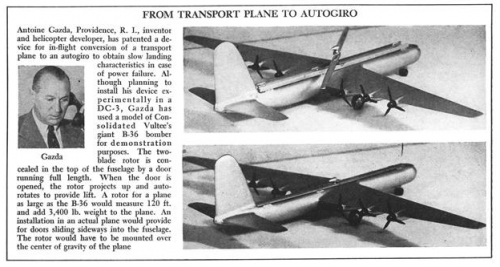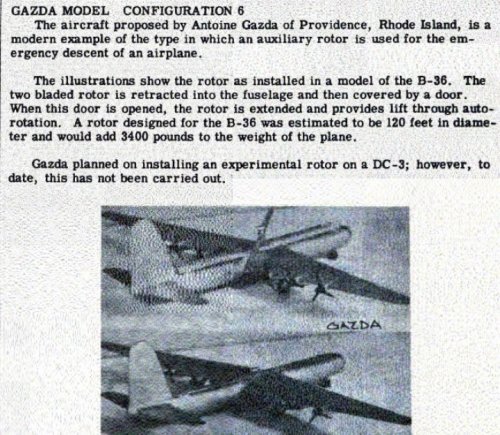- Joined
- 25 June 2009
- Messages
- 14,763
- Reaction score
- 6,174
the Gazda Model 100 Helicospeeder [NX69154] was a single-seat helicopter of all-aluminium construction designed by Antoine (Antonio) Gazda of Wakefield, Rhode Island in 1946. Gazda had been a World War I combat pilot, an ace, in the Austrian Air Force. A Swiss citizen, he had owned an aircraft factory in Switzerland that retracted into a mountain for military reasons. He also marketed the Fairchild 24 in Europe. After he emigrated to the USA, his personal friends included Governors and Senators, even the cousin of the King of England. During a general conversation, Harold E. "Hal" Lemont told Gazda of his work with Igor Sikorsky; Gazda asked if Lemont would like to design and build a helicopter for him. They
agreed that Lemont would lay out a design for a two-pJace helicopter, and thus the Gazda Model 100 was begun.
The Helicospeeder was manufactured by Helicopter Engineering & Construction Co. and designed in accordance with general practice at that time. The fuselage was welded steel aircraft tubing. Main rotor blades were steel tubular spars, wooden leading edge wire cable training edge and airplane fabric covering. Cast aluminum gear cases and industrial/automotive gears, bearings, belts, and pulleys were used. The wheels came from a Piper Cub. Considering the limited pool of knowledge and experience in helicopter design, and Mr. Lemont's earlier background with the Sikorsky VS-300, it is natural that there would be considerable similarity between these two machines.
The Gazda Model 100 had several very innovative design features, including:
Production examples were expected to sell for 5,000 U.S. dollars, but no firm sales were made. As Gazda came to understand the difficulty in learning to fly the aircraft, plus the cost of further development, he decided to discontinue further work on this innovative aircraft, and only one example of the initial version was completed. Antoine Gazda had also planned to build the Model 101 — intended to accommodate two persons — but no record of its completion has been found.
The Helicospeeder was sold at auction after Mr. Gazda passed away, and was purchased by HAl Past-Chairman Vincent Colicci, who eventually sold it to Dr. Voss. After some years at AgRotors in Pennsylvania, Stanley Hiller took it on loan for his aviation museum in San Carlos, California, and had it restored to its original condition (it would appear that the Model 100 was also placed on public display at some point in time in the Owls Head Transportation Museum at Knox County Regional Airport—located two miles south of Rockland, Maine.)
The Gazda Helicospeeder is a one-of-a-kind helicopter with many similarities to the VS-300 — yet has many unique and innovative features. Both the aircraft and its chief designer, Mr. Lemont, have earned a place in helicopter history.
Sources:
agreed that Lemont would lay out a design for a two-pJace helicopter, and thus the Gazda Model 100 was begun.
The Helicospeeder was manufactured by Helicopter Engineering & Construction Co. and designed in accordance with general practice at that time. The fuselage was welded steel aircraft tubing. Main rotor blades were steel tubular spars, wooden leading edge wire cable training edge and airplane fabric covering. Cast aluminum gear cases and industrial/automotive gears, bearings, belts, and pulleys were used. The wheels came from a Piper Cub. Considering the limited pool of knowledge and experience in helicopter design, and Mr. Lemont's earlier background with the Sikorsky VS-300, it is natural that there would be considerable similarity between these two machines.
The Gazda Model 100 had several very innovative design features, including:
- It was a helicogyro, having auxiliary propulsion.
- It had a single wheel/stick control:raise for collective; pull fore and aft and sideways for cyclic and turn wheel fordirectional control.
- It had an internal swash plate (belowthe main rotor gearbox) and internalmain rotor push rods.
- Its Cierva-type rotor hub, with hydraulicinterconnect links between blades, made ground resonance impossible.
- Initially, attempts were made to use ajet of air from the tail to counter torque. However, due to difficulties, a tail rotor was used that could be turned 90 degrees by the pilot, and thus serve as a push propeller for added thrust.
Production examples were expected to sell for 5,000 U.S. dollars, but no firm sales were made. As Gazda came to understand the difficulty in learning to fly the aircraft, plus the cost of further development, he decided to discontinue further work on this innovative aircraft, and only one example of the initial version was completed. Antoine Gazda had also planned to build the Model 101 — intended to accommodate two persons — but no record of its completion has been found.
The Helicospeeder was sold at auction after Mr. Gazda passed away, and was purchased by HAl Past-Chairman Vincent Colicci, who eventually sold it to Dr. Voss. After some years at AgRotors in Pennsylvania, Stanley Hiller took it on loan for his aviation museum in San Carlos, California, and had it restored to its original condition (it would appear that the Model 100 was also placed on public display at some point in time in the Owls Head Transportation Museum at Knox County Regional Airport—located two miles south of Rockland, Maine.)
The Gazda Helicospeeder is a one-of-a-kind helicopter with many similarities to the VS-300 — yet has many unique and innovative features. Both the aircraft and its chief designer, Mr. Lemont, have earned a place in helicopter history.
Sources:
- Wikipedia
- Rotor, Fall 1999
Attachments
-
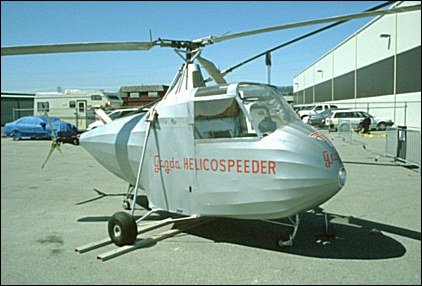 gazda_helicospeeder.jpg35.6 KB · Views: 606
gazda_helicospeeder.jpg35.6 KB · Views: 606 -
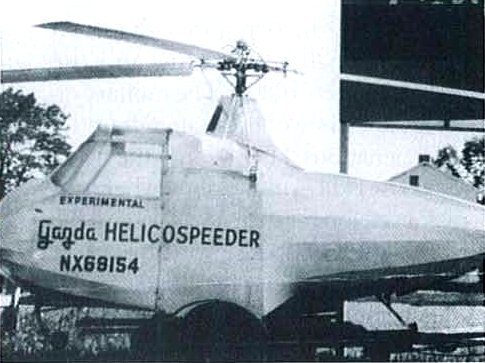 Gazda1.jpg111.6 KB · Views: 594
Gazda1.jpg111.6 KB · Views: 594 -
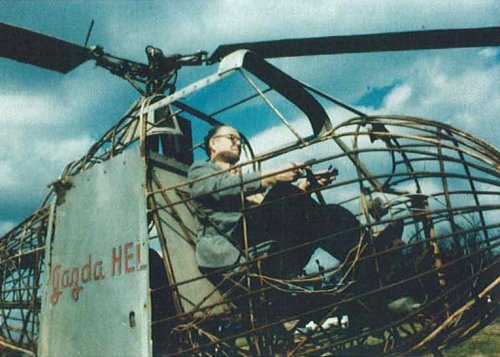 Gazda2.jpg291.4 KB · Views: 527
Gazda2.jpg291.4 KB · Views: 527 -
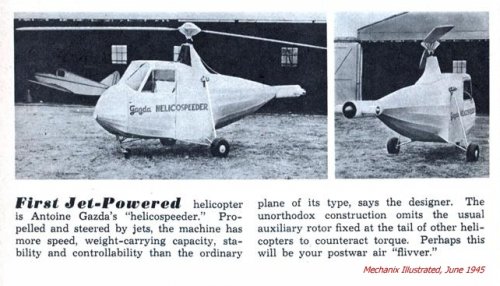 Gazda, June 1945.jpg157.4 KB · Views: 488
Gazda, June 1945.jpg157.4 KB · Views: 488 -
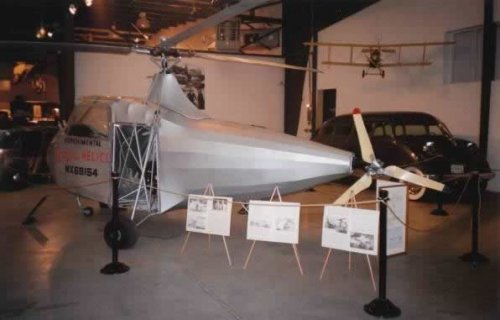 Gazda Heliospeeder.jpg19.4 KB · Views: 457
Gazda Heliospeeder.jpg19.4 KB · Views: 457 -
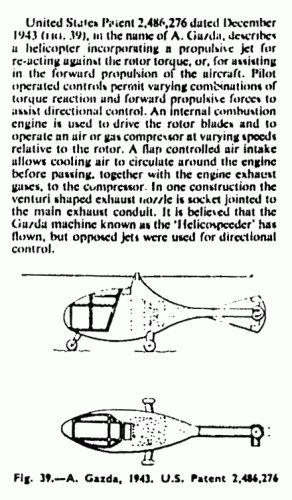 Gazda helicopter (US Patent 2,486,276).gif106.9 KB · Views: 65
Gazda helicopter (US Patent 2,486,276).gif106.9 KB · Views: 65 -
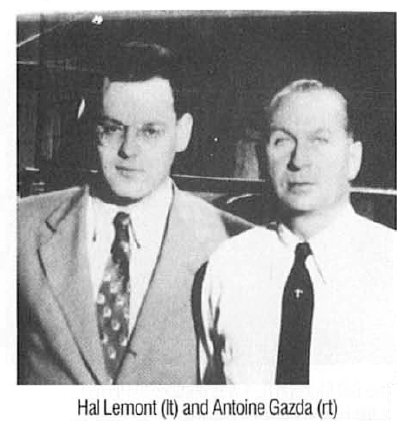 Lemont and Gazda.jpg83.2 KB · Views: 71
Lemont and Gazda.jpg83.2 KB · Views: 71

